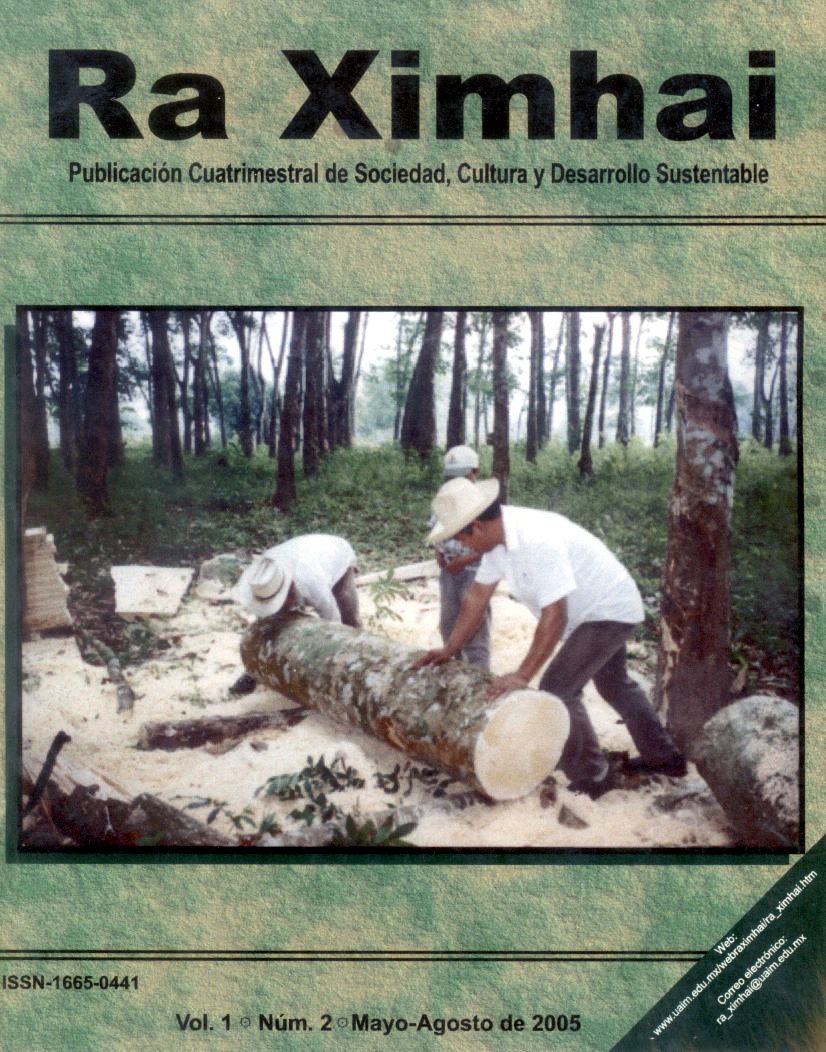Identification and variation of vegetation and land use in the Centla swamp reserve, Tabasco (1990-2000) using remote sensors and geographic information systems
DOI:
https://doi.org/10.35197/rx.01.02.2005.06.VGKeywords:
geographic information systems (GIS), remote sensing, Landsat, wetlandsAbstract
The spatial variation of vegetation types and land uses in the Pantanos de Centla Biosphere Reserve, Tabasco, was identified and quantified during 1990 and 2000. Digital geographic databases were generated regarding geology, edaphology, hydrology, minimum temperatures, maximum temperatures, precipitation, communication routes and localities. The information was stored in a geographic information system (GIS). Scenes from the Landsat satellite (1992, 2000) were classified using the mixed classification method of Chuvieco (1995). Vegetation maps were generated for 1990 and 2000 based on verification points and the generated maps were superimposed to obtain a map of changes. The tropical forest was the most affected ecosystem, with a considerable decrease in its surface area. The annual loss change rates were estimated at 6.06% (puckté forest) and 34.96% (tinto forest); The annual rate of increase was 1.15% (mangrove), 0.72% (hydrophyte communities) and 27.82% (grassland). The analysis indicates that the changes found were related to the presence of paved roads, towns and canals, the latter being the most affected. The results show that hydrophyte communities, grasslands and water bodies moved to all soil and geological units.
Downloads
References
Aranda, R.
“Instalaciones petroleras están inmersas en Pantanos de Centla, el ecosistema más rico y diverso del planeta”. In: La Crónica Hoy, Suplemento de Abril, México.
Berlanga, R.C. y Ruiz, L.A.
“Los manglares”. (En línea).
Disponible en http://www.selper.uabc.mx/Publicacio/cong97/te2.doc
Cervantes, M.
(En línea). Disponible en http//www.laneta.apc.org/emi/jornada/abril.html
CESPEDES
(En línea). Disponible en www.cce.org.mx/cespedes/publicaciones/otras/deforestacion/cap_4.htm
Chuvieco, E.
“Fundamentos de teledetección espacia”. Ed. Rialph, España. 453 p.
Cortina, V.S.; Macario, M.P.; Ogneva, H.Y.
“Cambios en el uso del suelo y deforestación en el sur de los estados de Campeche y Quintana Roo”. Boletín, núm. 38, Instituto de Geografía, UNAM, México. pp. 41-56.
Cruz, P. V.
“Impacto de las carreteras en las selvas de la Reserva de la Biosfera Pantanos de Centla, Tabasco”. Tesis de Licenciatura, UJAT. Pp. 15-42
De la Lanza, G.
(En líinea).Disponible en http://www.laneta.apc.org/emi/jornada/abril.html
Dirzo, R. y García, M.C.
“Rates of deforestation in Los Tuxtlas, a neotropical area in South east Mexico”. Conservation Biology 6(1): 84-90.
DOF
Poder Ejecutivo Federal. (Agosto 1992), Decreto de la Reserva de la Biosfera Pantanos de Centla, México.
DUMAC
(En línea). Disponible en http://www. dumac.org/dumac/habitat/index.html
Eastman, R.
“IDRISI User´s guide versión 4.0”. USA. pp.. 42-85.
ECOYUC
(En línea). Disponible en línea http://www.ecoyuc.com/humedales.html
Enríquez, G.C.
“Geomorfología e impacto ambiental en la Reserva de la Biosfera Pantanos de Centla, Tabasco”. Tesis de Licenciatura, UNAM. México. p. 4-26.
Francois, M. J.
(En línea). Disponible en http://www.selper.uabc.mx/Publicacio/Con9/te3.doc
Fuentes, L. y Soto, C.
“La Perspectiva Ambiental en los Sistemas de Información Geográfica”.
Memorias del 1er. Congreso Nacional de SIG. AMESIGE. México, pp. 39-40.
INE
(En línea) Disponible en http:// www.ine.gob.mx
INE-SEMARNAP
Programa de Manejo de la Reserva de la Biosfera Pantanos de Centla, México, 220 p.
Jensen, R.
“Introductory digital image processing”. Ed. Prentice Hall, USA. pp.225-252.
Lambin, E.F.
“Change detection at multiple temporal scales: seasonal and annual variations in landscape variables”. Photogrammetric Engineering & Remote Sensing 62(8): 931-938.
Lum, K.
(En línea). Disponible en http://www.laneta.apc.org/emi/jornada/abril.html)
RAMSAR
(En línea). Disponible en http:// www.ramsar.org/profiles_mexico.html
Romero, G.J.; García, M.A.; Bautista, J.A.; Pérez, A.P.
“Caracterización de la Reserva de la Biosfera Pantanos de Centla”.
Universidad y Ciencia 15 (30): 15-20.
Sánchez, J.
“Pierde México al año, 700 mil hectáreas de bosques”. In: el Universal sección estados. 08/jun. pp. A39.
SEMARNAP
(En línea).
Disponible en http://www.semarnat.gob.mx/produccion/rec-forestales/inv3.html
Velásquez, A., Mas, J.F., Díaz, J.R., Mayorga-Sucedo, R., Alcántara, P.C., Castro, R., Fernández, T., Bocco, G., Escurra, E., Palacio, J.L.
“Patrones y tasas de cambio de uso del suelo en México”. Gaceta ecológica, núm. 62, INE-SEMARNAT, México, pp. 21-37.
Downloads
Published
How to Cite
Issue
Section
License
Copyright (c) 2005 Verónica Guerra Martínez , Susana Ochoa Gaona

This work is licensed under a Creative Commons Attribution-NonCommercial 4.0 International License.
Usted es libre de:
- Compartir — copiar y redistribuir el material en cualquier medio o formato
- Adaptar — remezclar, transformar y construir a partir del material
- La licenciante no puede revocar estas libertades en tanto usted siga los términos de la licencia
Bajo los siguientes términos:
- Atribución — Usted debe dar crédito de manera adecuada , brindar un enlace a la licencia, e indicar si se han realizado cambios . Puede hacerlo en cualquier forma razonable, pero no de forma tal que sugiera que usted o su uso tienen el apoyo de la licenciante.
- NoComercial — Usted no puede hacer uso del material con propósitos comerciales .
- No hay restricciones adicionales — No puede aplicar términos legales ni medidas tecnológicas que restrinjan legalmente a otras a hacer cualquier uso permitido por la licencia.








